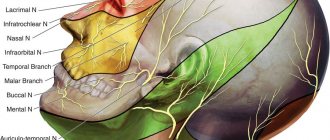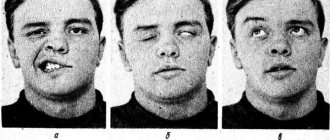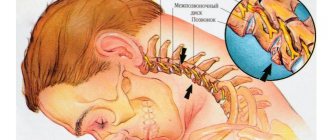Home|Facial nerve palsies|Mobius syndrome
This disease has been known to medicine since the end of the 19th century, but the possibilities for its treatment are still limited today, and the causes of its development have not been fully determined. Möbius syndrome is a congenital anomaly characterized by a lack of facial expression. Patients have difficulty swallowing, cannot laugh, and their face resembles a frozen mask. This pathology is also characterized by unilateral or bilateral paralysis of the facial nerve (complete or partial).
Children with Möbius syndrome immediately attract attention by the lack of facial reactions to external stimuli. They do not smile, and crying is accompanied only by sounds, without grimaces of displeasure on their faces.
Among the causes of Mobius syndrome, experts note the abnormal development of several (2 or 3) cranial nerves, abnormal development of the facial motor center, as well as destructive processes caused by hypoxia (changes in the fetus due to oxygen deficiency).
The main thing about the syndrome
This is a rare, poorly studied disease. It is detected in one in 30,000 newborns. It was first described in the 19th century and has since been systematically studied, but the causes of the disease have not yet been fully identified.
In addition, even in the 21st century, the pathology is difficult to treat, even if it is started in a timely manner. A child with such a disease looks emotionless - due to improper development of the cranial nerves, he is incapable of facial reactions.
He expresses his feelings with sound, for example, crying, but without a characteristic grimace. Such crying (or laughter, in case of pleasure) sounds unnatural, because it is difficult for the baby to control the vocal apparatus.
Today, the cause of the disease is usually listed as paralysis of the facial nerves, although it can also be associated with other processes in the body, such as a lack of oxygen inside the womb.
Mobius syndrome in children
Young children tend to express different emotions and quite often, so a child suffering from Mobius syndrome is immediately visible. He does not react in any way to external stimuli, does not cry, does not laugh, and even blinks with difficulty. Only by sounds can you vaguely understand what the baby needs.
From birth, such children have a motionless face, a clear asymmetry, a slightly open mouth, the eyes do not close well, and the child can only follow objects by moving his head. Retardation of mental development is rarely observed; the patient requires massage not only of the face, but also of the tongue, developing articulation classes.
Anatomy of cranial nerves
There are twelve pairs of cranial nerves, of which the first two arise from the brain, the rest from the trunk. Nerves are either sensory, that is, they carry sensations to the brain. Motor – control muscle movements, or mixed, both sensory and motor.
They innervate the head and neck region, with the exception of the tenth (vagus) nerve and several fibers of the 11th, which supply the chest and abdomen.
The VI cranial nerve is a motor nerve and innervates the lateral rectus muscle, which causes the eyeball to move laterally, that is, to the outer corners of the eyes. VII - mixed nerve, carries both sensory and motor impulses. The sensory part carries taste sensations from the outer 2/3 of the tongue, the soft and hard palate, which form the roof of the mouth, to the brain. The motor portion of the facial nerve controls the muscles of the face.
When the facial muscles contract, various emotions are visible on the face, such as a smile or forehead wrinkles. In addition, the facial nerve carries parasympathetic nerve fibers that control the secretion of saliva, mucous glands of the mouth and nose, and the secretion of the lacrimal gland.
Based on the extent of the disease, the disorder can be classified as:
- Moebius syndrome in children - VII and VI nerves are completely paralyzed on both sides;
- Incomplete syndrome - here some movements are present on one side of the face;
- Mobius-like forms - one side of the face is paralyzed, other cranial nerves are working.
The exact cause of Mobius syndrome is unknown. There are genetic and environmental factors.
Diagnosis of pathology
An anomaly such as Moebius syndrome is quite rare. Diagnosis is therefore difficult, especially in young children, and often leads to misdiagnosis, which is more dangerous and requires surgical treatment, for example:
- cerebral paralysis;
- blindness;
- deafness.
Examination and further therapy are being conducted in this direction.
Modern medicine cannot yet fully study the cause of this disease, therefore, it is also not possible to cure it completely. Research and study of the genetic material of patients at the chromosome level is being conducted in search of cell mutations.
Today, doctors set themselves the task of helping parents of children suffering from this syndrome in maintaining normal functioning at every stage of life. This is possible when correcting speech, strabismus, and gait.
Timely diagnosis is necessary not only to detect various forms of developmental disorders, but also to assess the degree of development of mental functions and identify psychological and clinical mechanisms of disorders.
The diagnosis of abnormal development includes psychological, pedagogical and clinical genetic research. It is carried out to determine the level of delay in emotional, behavioral, intellectual and speech development. It also influences the establishment of a connection between the underlying disease and other pathological manifestations, age and neurological condition of the patient.
Congenital anomalies
Bone and muscle abnormalities of the arms and legs. Club feet, missing fingers, short fingers or even a split hand. Club feet, where the feet turn inward at the ankles, are one of the most common bone deformities.
The breasts on one side of the body may be underdeveloped. Muscle tone is weak.
A child may have a small chin, a condition called micrognathia. Teeth may be missing or misaligned. The mouth is small with a short or unusually shaped tongue. The palate is high, arched or cleft.
These features add problems with speech development and feeding. The outer ear may be absent or underdeveloped. Hearing loss occurs if the VIII nerve is affected.
Symptoms
Patients with Marden-Walker syndrome have a variety of facial features, including abnormalities in the jaw, drooping eyelids, a flat bridge of the nose, low ears, and a fixed facial expression. Other manifestations of this disorder include curvature of the spine resulting in a hump, joint contractures, cleft or high arched palate, delayed growth and slow muscle movement.
Other symptoms of Marden-Walker syndrome may include a small head circumference, heart abnormalities, abnormalities in the urinary system, decreased bone mass, abnormally small eyes, a short neck, a small mouth, and/or a low hairline. A small number of patients with this condition may also have additional tissue causing small intestinal obstruction, a narrowing of the ring separating the stomach from the first part of the small intestine that causes a blockage in the flow of partially digested food (pyloric stenosis); and/or loss of appetite, inability of the body to absorb nutrients properly, stomach pain and weight loss.
The disease is in the nature of a neurological disorder when the child is unable to move the facial muscles and eyes from side to side. This symptom is the main one in the nature of the disease, but not the only one.
Other symptoms characteristic of this disease include:
- visual impairment;
- weakening of tongue function;
- anomalies in the anatomical structure;
- deformed feet;
- sensory processing disorder;
- violation of swallowing and sucking reflexes;
- facial skin tension;
- lack of tear secretion;
- disturbances in the functioning of the vestibular apparatus.
Möbius syndrome is a fairly rare disease, so diagnosing this disease in newborns is often difficult, which often leads to an incorrect diagnosis, which carries a certain risk for the baby’s health. A newborn may be diagnosed with cerebral palsy, blindness or deafness, which in itself is not true. Treatment, accordingly, will be carried out based on an incorrect diagnosis.
Diagnosis of Möbius syndrome in a newborn
Timely diagnosis of the disease is very important, as this will allow timely detection of various forms of developmental deviations, but will also reveal the psychological and clinical mechanisms of the disorders.
The most characteristic symptom of Mobius syndrome is the absence of facial expressions.
Other symptoms that help clarify the diagnosis include:
- abnormalities of body structure;
- complete or partial dysphagia (inability to swallow), difficulty sucking;
- Often, reduced intelligence is added to the symptoms; however, intelligence in patients with Mobius syndrome may be normal.
Babies with the syndrome are difficult to feed and care for, since their wishes often have to be guessed. They require additional care in a hospital setting until the symptoms of the disease are eliminated.
The disorder is diagnosed, as a rule, within a short time after birth. The diagnosis can only be made by a doctor based on available data on the symptoms of the disease. Usually no additional procedures are required to make a diagnosis.
Symptoms of the disease
Mobius syndrome is a congenital neurological disorder that is quite rare. People with this pathology lack the ability to move their facial muscles and eyes from side to side. This disease entails serious disturbances in the functioning of the musculoskeletal system and deformation of the feet.
The main clinical manifestation of the syndrome is limited mobility, but there are other, pronounced symptoms that confirm that this is Moebius syndrome:
- anatomical abnormalities;
- deformed foot;
- difficulty swallowing and sucking;
- sensory perception disorders;
- weakening of language functions;
- visual impairment.
There is also a violation of vestibular excitability and lack of tear secretion. The skin of a sick person's face is tense, without wrinkles even when laughing or crying. It does not move in relation to the subcutaneous tissue; the corners of the mouth are always lowered.
The defect is accompanied by limb anomalies such as syndactyly, clubfoot, brachydactyly and extra digits. With partial paralysis, the process mainly involves the muscles of the upper part of the face; the tissues do not sag as much as with an acquired disease.
Pathogenesis
Genetic determination and unfavorable antenatal conditions potentiate various disorders, delaying the formation of nuclei and roots of cranial nerves at the level of the brain stem. The facial and abducens nerves are primarily affected. Amymia occurs due to a disturbance in the innervation of the facial muscles.
Denervation of the muscle that rotates the eyeball outward causes convergent strabismus. Often Mobius syndrome involves underdevelopment of other cranial nerves located in the trunk. Hypoplasia of the glossopharyngeal, vagus, and hypoglossal nerves leads to disorders of sucking, swallowing, voice production, and articulation. When the VIII pair is underdeveloped, hearing loss is detected, while the V pair is characterized by a lack of sensitivity of the facial skin.
Genetic determination and unfavorable antenatal conditions potentiate various disorders, delaying the formation of nuclei and roots of cranial nerves at the level of the brain stem. The facial and abducens nerves are primarily affected. Amymia occurs due to a disturbance in the innervation of the facial muscles.
Denervation of the muscle that rotates the eyeball outward causes convergent strabismus. Often Mobius syndrome involves underdevelopment of other cranial nerves located in the trunk. Hypoplasia of the glossopharyngeal, vagus, and hypoglossal nerves leads to disorders of sucking, swallowing, voice production, and articulation. When the VIII pair is underdeveloped, hearing loss is detected, while the V pair is characterized by a lack of sensitivity of the facial skin.
What is Mobius syndrome?
Möbius syndrome (congenital facial diplegia) is a rare neurological disorder characterized by weakness or palsy of multiple cranial nerves, most commonly the 6th (abducens) and 7th (facial) nerves. Sometimes other cranial nerves are affected. The disorder is present at birth (congenital).
If the 7th nerve is involved, a person with Mobius syndrome may not smile, frown, purse their lips, raise their eyebrows, or close their eyelids. If the 6th nerve is affected, the eye is unable to rotate outward past the midline. Other abnormalities include underdevelopment of the pectoral muscles and limb defects.
Mobius syndrome does not progress. The exact reason is unknown. The syndrome appears to occur randomly (sporadic) in most cases; however, some cases occur in families, suggesting that there may be a genetic component.
Differential diagnosis
It is necessary to differentiate Moebius syndrome from tumor processes, encephalitis with damage to the brain stem, Down's disease, progressive bulbar palsy, and neuromuscular diseases. In rare cases, when Mobius syndrome occurs with unilateral facial paralysis, the pathology should be distinguished from intracerebral hematomas formed as a result of intracranial birth injury.
Imaging testing: CT scan, MRI are done to rule out any other causes of symptoms. Calcification is detected in the region of the nucleus of the VI cranial nerve. The brain stem may be underdeveloped, the VI, VII nerves are either underdeveloped or absent.
Marden-Walker syndrome. Causes
The causes of this disease in newborns have not yet been fully determined. Doctors' opinions on this matter are divided:
- the former believe that the reason for the development of pathology lies in the improper development of the cranial nerves;
- according to others, the development of pathology is associated with the negative impact of processes that arise as a result of oxygen starvation of the fetus during its intrauterine development;
- According to others, the cause of this rare disease lies in the improper development of the motor facial center.
In newborns with this syndrome, the sucking reflex is poorly developed; they are also unable to swallow food on their own, since their tongue functions are weakened. Sometimes the disease can occur in several family members at once.
Although the disease has been known for a long time, the causes of its occurrence are not fully known. Among the suspected causes, scientists identify abnormal development of cranial nerves and an anomaly in the development of the motor facial center. It is also believed that this anomaly is associated with abnormal intrauterine development of the fetus due to hypoxia.
The disease was first described in 1892 by the German physician Paul Moebius, from whose surname it received its name. The disease manifests itself in the pathology of the development of cranial nerves 6 and 7, and sometimes 3 and 12. This pathology manifests itself as facial paralysis and paralysis of the muscles responsible for lateral eye movement.
Sometimes Möbius syndrome is accompanied by hearing damage. Also, the pathology is often accompanied by other anatomical anomalies.
There are several reasons why this disease occurs. Which one exactly provokes facial nerve paralysis can only be guessed at. One of the reasons is asphyxia of newborns, more often used in the form of the terms “intrauterine hypoxia” or “fetal hypoxia”. Asphyxia (oxygen deficiency) can occur as a result of impaired uteroplacental circulation or due to various pathologies or infections during pregnancy.
The prognosis for children suffering from this rare disease is generally optimistic. There is currently no definitive way to get rid of facial paralysis. However, modern opportunities in medicine ensure that a child with such a disease can count on successful treatment and fully grow and develop on par with his peers.
Marden-Walker syndrome is inherited in an autosomal recessive manner. The exact genetic abnormality has not yet been established.
Complications
The prognosis for the life of children with Mobius syndrome is favorable. Most of these children lead a normal life, but modern society creates incredible difficulties for such children, preventing them from adapting among their peers. Constant ridicule and bullying from peers, especially in adolescence, undermines such children's self-confidence and makes them social outcasts.
This attitude towards them from others interferes with normal communication and development of the child. Often such children choose loneliness at a certain stage of their lives, which subsequently does not prevent them from starting a family, having friends and adapting to society.
The prognosis for newborns with Mobius syndrome is favorable. Surgical intervention will partially restore the functions of the facial nerves and give the child the opportunity to adapt in the future among his peers.
Most children with Mobius syndrome today have the opportunity to lead a normal and fulfilling life on an equal basis with other children.
The prognosis for the life of children with Mobius syndrome is favorable. Most of these children lead a normal life, but modern society creates incredible difficulties for such children, preventing them from adapting among their peers. Constant ridicule and bullying from peers, especially in adolescence, undermines such children's self-confidence and makes them social outcasts.
This attitude towards them from others interferes with normal communication and development of the child. Often such children choose loneliness at a certain stage of their lives, which subsequently does not prevent them from starting a family, having friends and adapting to society.
Swallowing disorders are dangerous due to food entering the respiratory tract with asphyxia. The accumulation of food debris in the oral cavity creates favorable conditions for the development of caries and other dental diseases. Due to disturbances in the structure and functioning of the upper respiratory tract (nasopharynx, larynx), respiratory infections often occur, which can be complicated by pneumonia.
Treatment
Children with Mobius syndrome rarely suffer from heart disease. Sometimes there is dextrocardia (the heart is located on the right side of the heart instead of the left), a ventricular septal defect, or abnormal attachments of large blood vessels to the heart (great vessel transfer or complete anomalous pulmonary venous connection).
Genetic counseling can be beneficial for patients and their families. Treatment is symptomatic and supportive only.
Conservative orthopedic treatment and physical therapy will be indicated. Developmental problems will be persistent and severe, but contractures are not progressive and will improve with age and physical therapy.
In relation to the disease, complex therapy is carried out, aimed at correcting existing congenital anomalies, maintaining the functioning of the brain, musculoskeletal system, and psychological support for the patient and his loved ones. Nutrition is provided using a special syringe, through a tube, and, if necessary, parenterally. The child is consulted by a pediatrician, a pediatric surgeon, a plastic surgeon, an ophthalmologist, a psychologist, and an orthodontist. Treatment includes the following components:
- Neurological. Supportive neurotropic pharmacotherapy with amino acids, nootropic, vascular, and vitamin preparations is carried out. Correction of amymia is performed surgically; the operation involves transplanting a muscle graft from the thigh to the face.
- Ophthalmological. In order to prevent complications of xerophthalmia, moisturizing eye drops are constantly instilled. If inflammation develops, antibacterial drops are prescribed. To protect the cornea, partial tarsorrhaphy is indicated - suturing the edges of the eyelids. Strabismus requires surgical treatment.
- Orthopedic. Involves surgical correction of malformations of the extremities: separation of the fingers in case of syndactyly, elimination of clubfoot, operations on the bones and joints of the foot. It is recommended to wear orthopedic shoes, regular exercise therapy, physiotherapy, and massage.
- Dental. Closing of the cleft palate, orthodontic treatment of malocclusions, and straightening of the dentition are carried out. In severe cases, treatment is carried out using maxillofacial surgery.
- Speech therapy. Articulation gymnastics and speech therapy massage are used. Regular classes with a speech therapist are prescribed to correct dysarthria, OHP.
- Psychological. Of great importance in complex treatment are the child’s sessions with a psychologist, child psychotherapy, art therapy, and psychological counseling of parents. For the purpose of social adaptation, older children take part in group psychological trainings.
What can you do
Since the causes of this disease are not fully understood, it is not possible to completely get rid of the pathology today.
It is for this reason that doctors are trying to help not only such children, but also their parents. In this matter, psychological assistance to parents is very important, which in turn will help support the normal functioning of the child at every stage of his development and maturation. Such children need the help of qualified specialists who can provide certain symptomatic assistance - correction of gait, speech, strabismus, etc.
What does a doctor do
There is currently no radical method of therapy in the treatment of this pathology. The only thing that modern medicine can offer in solving this issue is surgical intervention, the essence of which is to replace non-working muscles on the face with others, which are usually transplanted from the child’s hip.
The operation is quite complex and lasts about 9 hours, after which the child is transferred to the intensive care unit, where he must remain for several days.
Properly performed surgical intervention will make it possible to restore facial expressions. The child’s tongue function may be partially restored, he will be able to close his lips and subsequently adapt to society. Unfortunately, it is impossible to completely cure this disease.
What can you do
To date, there are no radical methods of treating this disease in children.
At the same time, parents of such a special child should know that in the process of his growing up and development, he can be provided with symptomatic assistance, which consists of correcting speech, pronunciation, strabismus, and more. The only way to help such children is to perform a surgical operation aimed at eliminating the defect of atrophied facial muscles. This operation will allow the child to partially restore his facial abilities and give him the opportunity to adapt among his peers.
What does a doctor do
Due to the fact that it is impossible to completely cure this pathology, the only way out of the situation seems to be surgical intervention, which is aimed at restoring facial expressions.
The essence of the operation is to replace atrophied facial muscles with others. Typically, muscles are taken from the thigh and transplanted to the face. The operation is technically complex and lasts about 9 hours. After this, the child will still have to spend several days in the intensive care unit.
In addition, the following activities will help alleviate the condition of a child with Mobius syndrome:
- early speech therapy work;
- special classes for the development of articulation;
- facial and tongue massage.
Moebius syndrome treatment | Saratov, Russia
Treatment of Mobius syndrome is aimed at restoring lost functions.
Treatment of the facial nerve
Sign up for a consultation. There are contraindications. Specialist consultation is required.
Photo (©) Fxquadro | Dreamstime.com \ Dreamstock.ru The people depicted in the photo are models, do not suffer from the diseases described and/or all similarities are excluded.
Related posts:
Depersonalization: causes, symptoms, treatment of depersonalization in Saratov, Russia
Urination, urination mechanism, why does it happen, does urinary incontinence happen?
Foville syndrome (ALF Foville) alternating pontine
Decerebrate rigidity: causes, symptoms, treatment
Opisthotonus: causes and treatment








